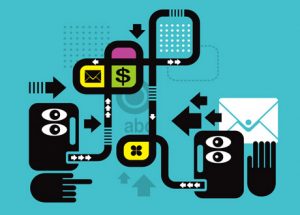 In the Nature of Technology W. Brian Arthur defines technology as the harnessing of natural phenomena to useful ends. The better understanding of those phenomena is called science.
In the Nature of Technology W. Brian Arthur defines technology as the harnessing of natural phenomena to useful ends. The better understanding of those phenomena is called science.
But, as Davidow points out, technology alone is not enough.
You have to productize technology: wrap it in a casing, slap a user interface on the front, write a user manual. Hire a sales guy.
In the innovation business, when we glimpse a technology in the throes of productization, we sit up and take note. Inventors go where no one has gone before. Inventions explore the space of the adjacent possible, like an inchworm standing at the end of a twig, reaching for a nearby leaf.
That worm – the inchworm of progress – can explore new points in known space. Business model innovations take existing dimensions and find new combinations. More of this, less of that. As Blue Ocean Strategy points out, Cirque du Soleil reinvented the circus by dialing animals down to 0 and acrobatics up to 11.
MBAs are comfortable with this sort of innovation. But the kind of people who read a lot of science fiction are not. Why? Because the this and the that are already known. The nerds say, “wake me when the worm finds a whole new dimension” – they want to see A Square go beyond Flatland.
New dimensions require technological invention. Without lithium batteries the modern laptop doesn’t exist. Without digital photography Flickr doesn’t exist.
 Whether the inchworm prospers or starves at that new point in product space then depends ondiffusion theory. Everett Rogers might say that an innovation is an invention in motion. And if the product ain’t moving, then the worm needs to keep crawling.
Whether the inchworm prospers or starves at that new point in product space then depends ondiffusion theory. Everett Rogers might say that an innovation is an invention in motion. And if the product ain’t moving, then the worm needs to keep crawling.
What does this have to do with JFDI?
In the last few months many people have asked us exactly what we do. The bootcamp is the easy answer, but it doesn’t tell the whole story.
I’d like to think that we’re in the business of productizing innovation.
Standing on the shoulders of Arthur’s framework, I would say that, for us, a constant supply of new inventions is the natural phenomenon, innovation is the technology, and new businesses are the product.
Would it help to unpack that statement?
A technology relies on a natural phenomenon, which is (sometimes) understood by science.
In architecture, the arch is a technology. It relies on the natural phenomenon that stone is weak in tension but strong in compression. And it relies on the epiphany, an insight into that phenomenon, that a spanning structure is possible which relies only on compression and not at all on tension.
In the absence of that insight, and of the understanding of the phenomenon behind it, the technology is absent. The Ancient Greeks had only the post and lintel. They did not have the arch. And the post and lintel doesn’t span very well: past a certain distance, the tensile forces snap the heavy beam in two. Too much weight in the middle! The epiphany is obvious in hindsight: if you carve away the parts that aren’t pulling their weight, as it were, then you end up with the arch.
A series of related epiphanies, exploring the adjacent possible, enable the arch to extend through space in one dimension (giving the barrel vault), in two dimensions (giving the groin vault), and in rotation (giving the dome). If you repeat the arch, you get a span: park it over a valley, and you get a bridge. Trickle water along the top, and you get an aqueduct.
 So the arch is a technology that enables hundreds of different products. And one technology enables another: as necessity is the mother of invention, the lateral forces that emerge from an arch eventually require a flying buttress.
So the arch is a technology that enables hundreds of different products. And one technology enables another: as necessity is the mother of invention, the lateral forces that emerge from an arch eventually require a flying buttress.
Technology is the serious older sibling, running errands and loading the wagon for the parents to bring to market. Science runs alongside, a younger sibling with short legs and a curious temperament, constantly asking “why?”
It’s important to ask why. In the Middle Ages sometimes the arches were too low, or the walls weren’t thick enough, and the building would just fall down. We had technology without science.
Now we have structural engineering and finite element analysis, and our buildings stay up.
Many people talk about the importance of productizing innovations. I understand their intent but I find their vocabulary imprecise. I would say that innovation is the process of productizing and diffusing inventions.
The very fact that it is possible to have disagreements about jargon is a sign that the field is maturing.
And the maturation of that field is one of the phenomena that I want to harness.
Innovation is maturing from alchemy to chemistry, just as architecture did a century ago.
For most of its history, innovation has been regarded as a magical, mercurial thing. Sometimes it works, sometimes it doesn’t. A council of elders sits on the sidelines and places bets. But at the end of the day you just have to try, and to the victor the spoils.
Now things are changing. The phenomena around innovation are beginning to be understood. The technologies are falling into place. It’s not marketing any more: it’s “growth hacking.” The unknowns are being engineered out.
Thanks to advances like these, startups are becoming more science and less art. And these technologies are begetting advances in the space of the adjacent possible: the technologies of innovation can also serve innovators in academia (tech transfer offices) and by big corporations (intrapreneurship and spin-outs).
This is the sort of Prigoginic leap in the level of complexity that Kevin Kelly talks about in What Technology Wants.
But, as we said in the beginning, technologies are not enough. They need to be productized.
And that’s what JFDI is doing. We’re going one level meta. We are productizing the concept of innovation itself.

The concepts of insight, invention, and innovation are themselves a technology. The patent system is an artefact of that technology.
But inventions are not enough. If you want to move those inventions to market, you need innovation.
Innovation has not been well understood – until now.
We take that technology – the technologies of innovation – to market. Do not confuse this with “an innovative technology”. That’s an instance. We deal with the class. A tech startup may use innovative technologies like Ruby on Rails and Twitter Bootstrap to build apps. We use innovation technologies like Lean, Customer Discovery, and Disruption Theory to build startups. We are one level up the complexity hierarchy.
Our first line of business was the seed accelerator, which offers a product – the 100-day bootcamp – to the independent entrepreneur.
But independent entrepreneurs form only one segment of the market. Academia and corporates are others. Now we’re building lines of business for them too.


Excellent Post. I believe we have spent the last two decades understanding the innovations (not inventions) in the Information Technology space and now we really have ‘critical mass’ who understand innovations and can help create products.
Let me try to decode a bit of what you have said.
‘Inventions are natural phenomena’. ‘Innovations’ are byproducts of Inventions and in this context, technology. The next stage is Application of Innovation.
And JFDI ‘s focus now is to ‘Productize’ Innovations and help develop Business Products. Is this Right?